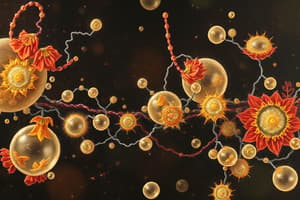Podcast
Questions and Answers
Which type of molecule is not normally found in living things?
Which type of molecule is not normally found in living things?
- Proteins
- Lipids
- Inorganic molecules (correct)
- Carbohydrates
Which type of reaction requires an input of energy?
Which type of reaction requires an input of energy?
- Biuret reagent
- Benedict's reagent
- Hydrolytic Reactions
- Dehydration Synthesis (correct)
What color does Benedict's reagent turn when monosaccharides are present?
What color does Benedict's reagent turn when monosaccharides are present?
- Blue
- Green
- Yellow
- Red (correct)
What is the purpose of Sudan IV in the Sudan IV test for lipids?
What is the purpose of Sudan IV in the Sudan IV test for lipids?
What color does the Biuret reagent turn after reacting with peptide bonds?
What color does the Biuret reagent turn after reacting with peptide bonds?
What are monomers of proteins called?
What are monomers of proteins called?
What type of bonds hold amino acids together in proteins?
What type of bonds hold amino acids together in proteins?
What is the purpose of the Dische Diphenylamine Test?
What is the purpose of the Dische Diphenylamine Test?
How many different amino acids are there in living things?
How many different amino acids are there in living things?
What type of reactions release energy?
What type of reactions release energy?
Which domain does Escherichia coli belong to?
Which domain does Escherichia coli belong to?
What is the main function of the pseudopodia in Amoeba?
What is the main function of the pseudopodia in Amoeba?
Which kingdom does Eudorina belong to?
Which kingdom does Eudorina belong to?
What is the function of the flagellum in Eudorina?
What is the function of the flagellum in Eudorina?
Which domain does Elodea belong to?
Which domain does Elodea belong to?
What is the main function of the central vacuole in Elodea?
What is the main function of the central vacuole in Elodea?
Which kingdom does Solanum sp. (Potato) belong to?
Which kingdom does Solanum sp. (Potato) belong to?
What is the main function of amyloplasts in Solanum sp. (Potato) cells?
What is the main function of amyloplasts in Solanum sp. (Potato) cells?
What was visible in the Onion peel cells under the microscope?
What was visible in the Onion peel cells under the microscope?
Which kingdom does Saccharomyces sp. (Yeast) belong to?
Which kingdom does Saccharomyces sp. (Yeast) belong to?
Which of the following is true about enzymes?
Which of the following is true about enzymes?
What is the primary structure of a protein?
What is the primary structure of a protein?
Which of the following is true about hydrogen bonds in proteins?
Which of the following is true about hydrogen bonds in proteins?
What is the active site of an enzyme?
What is the active site of an enzyme?
What happens during induced fit in enzyme-substrate interaction?
What happens during induced fit in enzyme-substrate interaction?
Why are only small amounts of enzymes needed in reactions?
Why are only small amounts of enzymes needed in reactions?
What is the reaction rate of an enzyme?
What is the reaction rate of an enzyme?
What happens to enzyme activity at temperatures lower than the optimum?
What happens to enzyme activity at temperatures lower than the optimum?
What happens to enzyme activity at temperatures higher than the optimum?
What happens to enzyme activity at temperatures higher than the optimum?
What is the effect of temperature on enzyme activity?
What is the effect of temperature on enzyme activity?
Flashcards are hidden until you start studying
Study Notes
Biomolecules and Reactions
- Inorganic molecules are not normally found in living things.
- Endergonic reactions require an input of energy.
- Exergonic reactions release energy.
Carbohydrate Tests
- Benedict's reagent turns blue-green when monosaccharides are present.
- The purpose of Sudan IV in the Sudan IV test for lipids is to stain lipids.
Protein Structure and Function
- Monomers of proteins are called amino acids.
- Amino acids are held together in proteins by peptide bonds.
- The Biuret reagent turns purple after reacting with peptide bonds.
- There are 20 different amino acids found in living things.
Cell Biology
- The purpose of the Dische Diphenylamine Test is to detect the presence of DNA.
- Escherichia coli belongs to the domain Bacteria.
- The main function of the pseudopodia in Amoeba is to capture food and move around.
- Eudorina belongs to the kingdom Protista.
- The function of the flagellum in Eudorina is to move around.
- Elodea belongs to the domain Eukarya.
- The main function of the central vacuole in Elodea is to store water and maintain turgor pressure.
- Solanum sp. (Potato) belongs to the kingdom Plantae.
- The main function of amyloplasts in Solanum sp. (Potato) cells is to store starch.
- Cell walls and cell membranes were visible in the Onion peel cells under the microscope.
- Saccharomyces sp. (Yeast) belongs to the kingdom Fungi.
Enzymes
- Enzymes are highly specific to their substrates.
- The primary structure of a protein is its sequence of amino acids.
- Hydrogen bonds in proteins are weak and contribute to the protein's 3D structure.
- The active site of an enzyme is the region where the substrate binds.
- During induced fit, the enzyme's active site changes shape to fit the substrate.
- Only small amounts of enzymes are needed in reactions because they are highly efficient.
- The reaction rate of an enzyme is affected by factors such as temperature, pH, and substrate concentration.
- Enzyme activity decreases at temperatures lower than the optimum.
- Enzyme activity often increases at temperatures higher than the optimum, but can eventually denature the enzyme.
- Temperature affects enzyme activity by altering the protein's shape and active site.
Studying That Suits You
Use AI to generate personalized quizzes and flashcards to suit your learning preferences.




